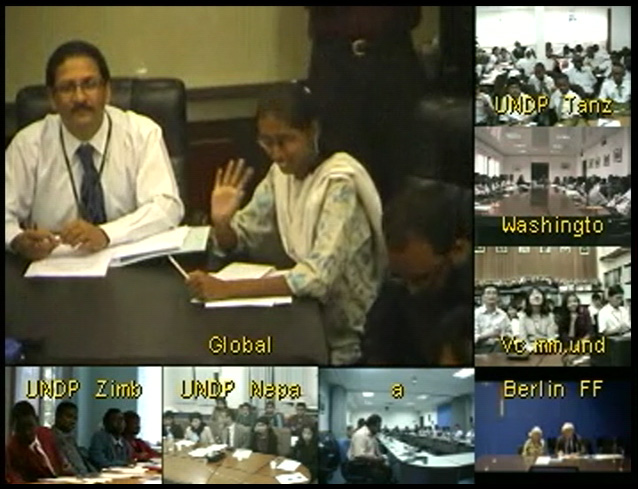Video Conference with the House of the Wannsee Conference Memorial and Educational site and UNICs in Africa and Asia
72nd Anniversary Observance of the Kristallnacht pogrom
(15 November 2010)

On 15 November 2010 the Holocaust and the United Nations Outreach Programme, in cooperation with the House of the Wannsee Conference Memorial and Educational site, organized a special students videoconference with United Nations Information Centres (UNICs) in Africa and Asia to commemorate the anniversary of the Kristallnacht pogrom that took place on 9 November 1939 in Germany.

A total of 150 high-school students in seven countries were brought together by UNICs Accra, Colombo, Dar es Salaam, Dhaka, Harare, Kathmandu and Yangon for a briefing on Kristallnacht and the Holocaust. They also had the unique opportunity to listen to the testimony of Ms. Margot Friedlander, Holocaust survivor, and ask her questions about her personal experience.
Born to a Jewish family in Berlin in 1921, Margot was sent to a forced labour factory at the age of 20. After the arrest of her mother and brother, Margot found herself completely alone in Nazi Germany and had no choice but to go into hiding. For fifteen months, Margot’s life depended on “people who shared their home and their food with me, people that I had never seen before, people who had the courage to do the right thing, [and] risked their lives” she told the students.

But in 1944 she was arrested and deported to the Theresienstadt concentration camp in Nazi-occupied Czechoslovakia where she managed to survive for a year, despite the terrible conditions. While transports to the death camps in the East left on a regular basis, Margot was miraculously spared from the numerous deportations to Auschwitz Birkenau. She was still a prisoner at Theresienstadt when wagons of barely alive transports arrived from the East by train, sent by the Nazi's just prior to the arrival of the Soviets. She described these prisoners as “men that were not human any more” with “terror in their eyes”. “This was the moment I knew I would never see my mother and my little brother again” she said. Later she learnt that most of her family had been murdered in Auschwitz Birkenau.
“Try to make your life” was the last message Margot received from her mother and the title of the memoirs she published in 2008. “My will to live, to follow the wishes of my mother gave me the strength to try [to survive]”.
Margot met her husband Adolf Friedlander in the camp and married him after liberation. From Theresienstadt they went to a camp for displaced persons in southern Germany. In July 1946 they immigrated to the United States.

Asked how she managed to overcome the trauma of the Holocaust, Margot said “Life goes on, you have to try to make the best of it”. “I want to look forward” she added. Upon invitation by the German Senate, Margot returned to her home town Berlin in 2003 for the first time in over fifty years. In 2010 she decided to live there permanently and just celebrated her 89th birthday.
Many questions were asked by the local students, amongst which were: “How did the Holocaust affect your life?”, “What was your most memorable moment in the camp?”, “How did you feel the first time you came back to Berlin?”, “How did you feel after surviving the Holocaust?”

Asked by a student what could be done by young people in the world to help to prevent future acts of genocide, Margot replied: “You can do a lot. First of all, [look at other people] as other human beings. Be respectful of other people [regardless of ethnicity or religion]. When you hear people talk badly, use your own judgement to answer them. I respect people and you should respect everyone, too”. “I am going to schools, libraries to talk to people about our experience to tell them my feelings, wishes and hopes. My mission as a survivor, in memory not only of my parents but also of six million people [who perished] is to do something so that it doesn’t happen again”, she concluded.
In attendance at UNIC Yangon were also H.E. Julius Georg Luy, German Ambassador in Myanmar, and H.E. Yaron Mayer, Ambassador for Israel in Myanmar.
Prior to the video conference, the United Nations Information Centres briefed the students on the history of the Holocaust, using tools such as the United Nations Holocaust Programme’s “Footprints for Hope” kit or the “Electronic Notes for Speakers”.
The House of the Wannsee Conference is a long-time partner of the Holocaust and the United Nations Outreach Programme. In 2008, the two institutions developed a week-long training seminar in English for the National Information Officers of 24 United Nations Information Centres from Africa and Asia on the history of the Holocaust and genocide prevention.
WEBCAST
Press Release: United Nations Video Conference with Students of Seven Countries on 15 November Will Mark Anniversary of Kristallnacht Pogrom in 1938 (12 November 2010)